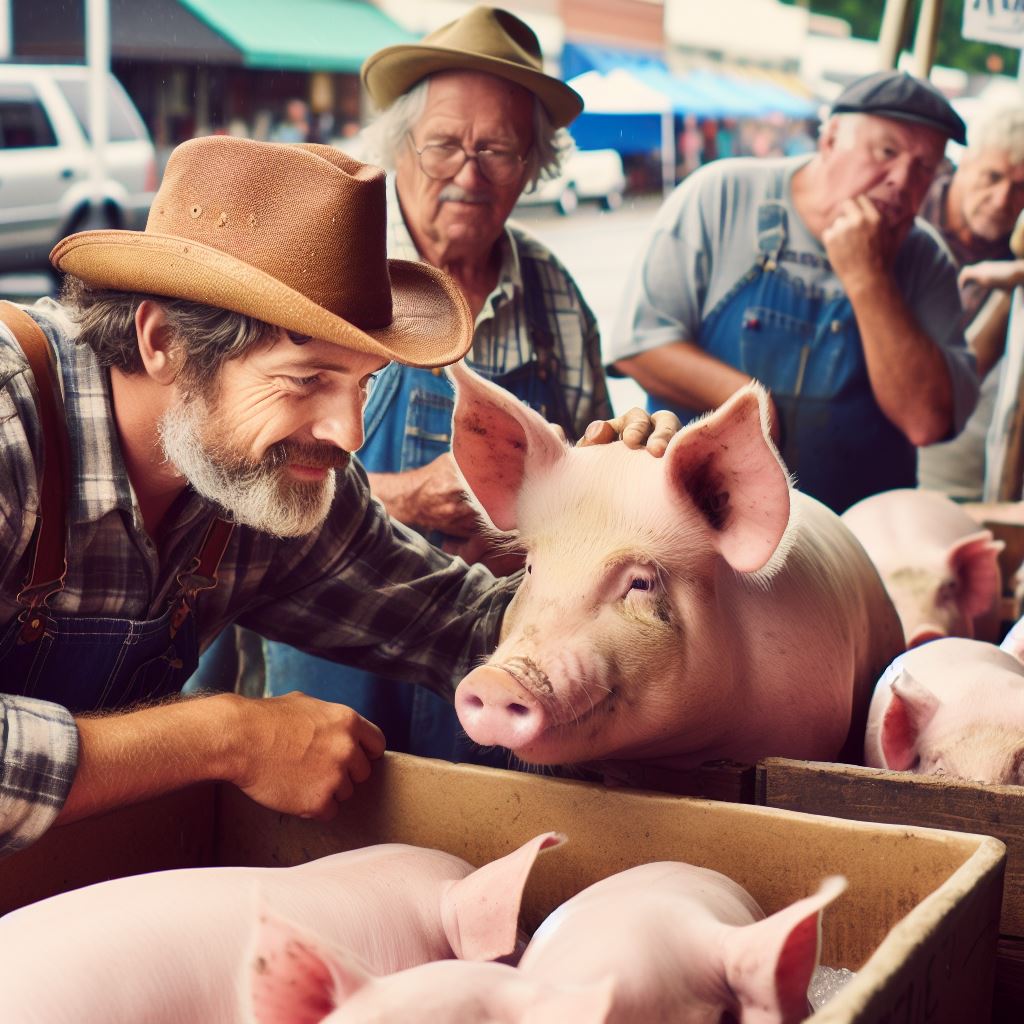Introduction
A. Definition and Importance of Cost-Efficient Pig Farming
Cost-efficient pig farming, the strategic management of resources, is pivotal for sustainable agricultural practices.
- Enhances Profitability: Implementing cost-effective measures directly impacts the bottom line, ensuring a profitable pig farming venture.
- Sustainable Practices: Cost efficiency promotes eco-friendly farming, reducing waste and minimizing environmental impact.
- Resource Optimization: Streamlining feed, housing, and healthcare resources optimizes production inputs, fostering a resilient and economical pig farming system.
- Risk Mitigation: Cost-effective strategies mitigate financial risks, safeguarding against market fluctuations and unexpected challenges in the industry.
- Technological Integration: Embracing technology in pig farming operations enhances efficiency, reducing manual labor costs and improving overall productivity.
- Healthier Livestock: Prioritizing cost-efficient healthcare practices ensures the well-being of the pigs, preventing diseases and minimizing veterinary expenses.
- Compliance with Regulations: Adhering to cost-efficient yet compliant farming practices aligns with industry regulations, ensuring a sustainable and lawful operation.
In essence, understanding and implementing cost-efficient pig farming practices are crucial for long-term success, profitability, and environmental sustainability in the agricultural sector.
Proper Planning for Cost-Efficient Pig Farming
A successful pig farming venture starts with a solid plan.
Proper planning ensures that you are on the right track and will help you avoid expensive mistakes.
A. Identifying goals and objectives
- Clearly define your goals and objectives for your pig farming business to stay focused.
- Set realistic targets for production, profits, and expansion to measure your success.
- Consider factors such as the number of pigs you want to raise and the target market.
- Identify whether you aim to sell live pigs, pork products, or both.
- Establish if you want to breed pigs or buy weaners to raise for market.
B. Conducting market research and feasibility study
- Research the pig market to determine current demand, prices, and competitors.
- Identify potential customers and understand their preferences and buying behavior.
- Assess the feasibility of pig farming in your area based on the available resources.
- Consider factors like land availability, access to water, and proximity to markets.
- Ensure you have a clear understanding of the financial investment required.
C. Developing a comprehensive business plan
- Create a detailed business plan that outlines your strategies and operations.
- Include sections on pig management, feeding, breeding, health, and waste management.
- Plan your marketing and sales strategies to penetrate the target market effectively.
- Calculate your startup costs, ongoing expenses, and projected revenue streams.
- Consider incorporating sustainability practices to reduce costs and increase efficiency.
Proper planning is crucial in optimizing your pig farming operations and achieving cost-efficiency.
It ensures that you have a clear direction, minimize risks, and maximize profits.
Read: Innovations in Swine Welfare
Investment Considerations
When it comes to cost-efficient pig farming, there are several investment considerations that can greatly impact the financial success of your operation.
In this section, we will explore some key factors that pig farmers should take into account in order to maximize profitability.
A. Budgeting and Financial Analysis
Effective budgeting and financial analysis are crucial for any pig farming venture.
It is important to carefully plan and track your expenses, including feed, labor, medication, and infrastructure costs.
By developing a detailed budget, you can identify potential areas of overspending and find ways to optimize your expenses.
In addition to budgeting, conducting regular financial analysis will help you monitor the performance of your pig farming operation.
By analyzing key financial indicators such as revenue, profit margin, and return on investment, you can identify trends and make informed decisions to improve your bottom line.
B. Identifying and Procuring Necessary Equipment and Infrastructure
Pig farming requires various types of equipment and infrastructure to ensure efficient operations.
Transform Your Agribusiness
Unlock your farm's potential with expert advice tailored to your needs. Get actionable steps that drive real results.
Get StartedIt is essential to determine the specific needs of your farm and invest in the necessary equipment accordingly.
This may include items such as feeding systems, ventilation systems, water supply equipment, and pig handling facilities.
When procuring equipment, it is important to consider factors such as durability, efficiency, and cost-effectiveness.
Opting for high-quality equipment may initially require a larger investment, but it can result in long-term savings by reducing maintenance and replacement costs.
C. Ensuring Proper Waste Management Systems
Waste management is a critical aspect of pig farming that should not be overlooked.
Proper waste management not only ensures environmental sustainability but also contributes to cost reduction by minimizing waste-related expenses.
Implementing efficient waste management systems can include methods such as composting, anaerobic digestion, or biogas production.
These systems help convert pig waste into valuable resources, such as fertilizer or renewable energy, reducing the need for external inputs and lowering overall operational costs.
Investment considerations play a significant role in the success of cost-efficient pig farming.
By taking the time to budget, analyze finances, procure suitable equipment, and implement effective waste management systems, pig farmers can optimize their operations and increase profitability.
Remember, careful planning and decision-making are key to achieving long-term financial sustainability in pig farming.
Read: Organic Feed for Healthy Pigs
Optimizing Feed Efficiency
A. Balancing nutrition and diet formulation
- Ensure that pigs receive a well-balanced diet to meet their nutritional requirements.
- Consult a nutritionist to create a diet formulation that provides adequate levels of protein, energy, vitamins, and minerals.
- Regularly evaluate and adjust the diet based on the pig’s growth stage and specific nutritional needs.
- Use high-quality feed ingredients and consider potential nutrient interactions to maximize feed efficiency.
B. Incorporating locally sourced ingredients
- Utilize locally sourced feed ingredients to reduce transportation costs and support local agriculture.
- Work with local farmers and suppliers to identify affordable and available ingredients that meet nutritional requirements.
- Test new ingredients and monitor pig performance to ensure they are effective and safe in the diet.
- Consider using by-products or alternative feed sources to reduce costs without compromising nutrition.
C. Utilizing feeding techniques to reduce waste and maximize growth
- Implement an appropriate feeding system that minimizes feed wastage, such as using feeders with limited access for pigs.
- Feed pigs in smaller, more frequent meals to ensure efficient nutrient utilization and minimize waste.
- Monitor pigs’ feed intake and adjust the diet accordingly to prevent overfeeding or underfeeding.
- Consider implementing precision feeding technologies to optimize feed allocation based on individual pig needs.
Read: Managing Pig Health: Disease Control
Disease Management and Biosecurity Measures
A. Regular health monitoring and preventive measures
- Conduct regular health check-ups for pigs to detect any signs of illness early.
- Implement proper hygiene practices such as cleaning and disinfecting pig pens regularly.
- Quarantine new pigs to ensure they are disease-free before introducing them to the existing herd.
- Train farm workers on proper handling and care practices to prevent the spread of diseases.
- Provide a balanced and nutritious diet to boost pigs’ immunity and overall health.
B. Implementing biosecurity practices to minimize disease outbreaks
- Control access to the pig farm by restricting entry to authorized personnel only.
- Use dedicated clothing and footwear for each area of the farm to prevent cross-contamination.
- Keep a logbook of visitors and activities on the farm for traceability purposes.
- Install proper fencing and secure gates to prevent unauthorized access by animals and pests.
- Implement a strict animal transportation protocol to prevent the introduction of diseases.
C. Engaging veterinary support and vaccination protocols
- Collaborate with a veterinarian to develop and implement a herd health management plan.
- Ensure regular vaccinations are administered to protect pigs against common diseases.
- Conduct periodic veterinary visits to monitor the overall health status of the herd.
- Keep a record of vaccination schedules and administer them at the recommended intervals.
- Seek veterinary advice promptly in case of illness or disease symptoms in pigs.
By following these tips on disease management and biosecurity measures, pig farmers can reduce the risk of disease outbreaks and ultimately improve the profitability and sustainability of their operations.
Read: Sustainable Pig Farming Techniques

Enhanced Reproduction and Breeding Strategies
A. Selecting high-quality breeding stock
- Identify pigs with desirable traits such as good conformation and strong genetics.
- Conduct thorough health assessments to ensure they are disease-free.
- Select breeding stock from reputable breeders or reliable sources.
- Consider the productivity and performance records of the animals before making a decision.
- Regularly evaluate and replace low-performing or genetically inferior animals to maintain the overall quality.
B. Managing estrus synchronization and artificial insemination
- Implement a controlled reproductive program to optimize breeding efficiency.
- Monitor estrus signs in female pigs to accurately determine the best time for insemination.
- Utilize reproductive hormones or prostaglandins to synchronize estrus cycles among a group of sows.
- Train or hire skilled technicians to perform artificial insemination techniques accurately.
- Keep proper records of breeding dates, boar used, and other relevant information to track results and improve future breeding strategies.
C. Establishing proper nesting and farrowing management practices
- Ensure the farrowing area provides a comfortable and safe environment for the sows and piglets.
- Install farrowing crates or pens with appropriate heating and ventilation systems.
- Set up clean and well-bedded nests to minimize the risk of piglet crushing and maximize piglet survival.
- Monitor sows closely during farrowing and provide assistance when necessary.
- Implement a strict hygiene protocol to prevent the spread of diseases and infections within the farrowing area.
By implementing these enhanced reproduction and breeding strategies, pig farmers can significantly improve their herd’s performance, productivity, and overall profitability.
Selecting high-quality breeding stock ensures the transmission of desirable traits and genetics to future generations.
Through proper estrus synchronization and artificial insemination, farmers can precisely time breeding activities and increase the success rate of fertilization.
Additionally, establishing appropriate nesting and farrowing management practices creates a healthy and safe environment for both sows and piglets, reducing the risk of mortality and optimizing piglet survival.
It is important to regularly evaluate and update these strategies to adapt to changing market demands and advancements in the field of pig farming.
By staying informed about new technologies, genetic improvements, and best practices, farmers can continue to enhance their reproduction and breeding strategies, leading to a sustainable and cost-efficient pig farming operation.
Reducing Operational Costs
In order to maximize profitability in pig farming, reducing operational costs is crucial.
By implementing the following strategies, farmers can save money and run a cost-efficient operation.
A. Efficient utilization of labor force
- Assign specific tasks to each member of the labor force, ensuring that their skills are utilized effectively.
- Conduct regular training sessions to improve the knowledge and efficiency of the labor force.
- Implement time management techniques to ensure tasks are completed in a timely manner.
- Consider hiring part-time or seasonal workers during peak periods to maintain optimal staffing levels.
- Regularly evaluate labor force performance and provide feedback to encourage productivity.
B. Utilizing technology and automation
- Invest in modern farming equipment and machinery to streamline operations and increase productivity.
- Use automated feeding systems to deliver the right amount of feed to each pig, minimizing waste.
- Install sensors and monitoring systems to track temperature, humidity, and other environmental factors, optimizing pig health.
- Employ computerized record-keeping systems to accurately track expenses, income, and herd performance.
- Explore the use of robotics in tasks such as cleaning, waste management, and milking.
C. Exploring cooperative initiatives and group purchasing
- Collaborate with other pig farmers to form a cooperative and collectively purchase inputs at discounted prices.
- Share resources, such as machinery, to minimize individual costs and improve efficiency.
- Pool resources to negotiate better deals with suppliers, reducing the cost of essential items.
- Join industry associations to access group purchasing programs and benefit from economies of scale.
- Participate in knowledge-sharing networks to exchange cost-saving tips and best practices with fellow farmers.
By implementing these cost-efficient measures, pig farmers can significantly reduce their operational expenses and improve their overall profitability.
Showcase Your Farming Business
Publish your professional farming services profile on our blog for a one-time fee of $200 and reach a dedicated audience of farmers and agribusiness owners.
Publish Your ProfileIt is important to regularly reassess and refine these strategies to adapt to changing market conditions and technological advancements.
Marketing and Value-Added Opportunities
Marketing and finding value-added opportunities in pig farming can significantly increase profitability and sustainability.
By identifying target markets and understanding value chains, farmers can tailor their production and marketing efforts to meet specific customer needs.
Building strong relationships with buyers and suppliers is essential for long-term success, ensuring a reliable market for your products and a steady supply of inputs.
Additionally, exploring diversification options and value-added products can open up new revenue streams and enhance the overall profitability of your pig farming business.
A. Identifying target markets and value chains
To identify target markets and value chains, conducting thorough market research is crucial.
This helps you understand the demographics, preferences, and purchasing patterns of potential customers.
Analyzing the value chain enables you to identify the key players involved in delivering your products to consumers and identify opportunities to add value at different stages.
By focusing on niche markets and offering unique products or services, you can differentiate yourself from competitors and attract customers who are willing to pay a premium for your offerings.
Developing a comprehensive marketing plan that aligns with the identified target markets is essential.
This plan should include the positioning of your products, pricing strategies, promotional activities, and distribution channels.
Leveraging social media and online platforms can significantly expand your reach and raise awareness about your brand and products.
B. Building strong relationships with buyers and suppliers
Building strong relationships with buyers and suppliers is crucial in a competitive market.
Consistently delivering high-quality products establishes credibility and fosters trust with potential buyers.
Offering competitive pricing and flexible payment terms can attract buyers and encourage repeat purchases.
Open communication with suppliers ensures a steady supply of inputs at reasonable prices, reducing production costs and ensuring the reliability of your operations.
C. Exploring diversification options and value-added products
Exploring diversification options and value-added products can help maximize profits and minimize risks.
Continuously evaluating your product offerings and identifying opportunities for diversification allows you to adapt to changing market demands and potentially enter new market segments.
Adding value to your products through processing or packaging can command higher prices and create a unique selling proposition.
Additionally, exploring the potential of by-products or waste materials for alternative revenue streams can contribute to overall profitability and sustainability.
Collaborating with other businesses through strategic partnerships can create synergy and lead to the development of value-added products.
By combining resources and expertise, you can create innovative products or joint promotional activities that attract a wider customer base.
It is also worth exploring government programs or grants that support innovation and diversification in the agricultural sector as they can provide financial support and guidance in implementing new ideas.
In short, successful marketing and value-added opportunities are vital for the success of pig farming businesses.
By identifying target markets, building strong relationships with buyers and suppliers, and exploring diversification options, farmers can enhance profitability, differentiate themselves from competitors, and ensure long-term sustainability.
Implementing these strategies will help pig farmers thrive in a competitive market and seize opportunities for growth.
Conclusion
It is crucial for pig farmers to adopt cost-efficient practices in order to maximize their profits and sustain their businesses in the long run.
By following the key tips mentioned in this blog section, farmers can effectively reduce expenses and improve their overall productivity.
To recap, some of the cost-efficient pig farming tips include optimizing feed utilization, managing waste and manure efficiently, utilizing natural resources, implementing proper biosecurity measures, and exploring alternative sources of energy.
It is important for farmers to understand that implementing these strategies may require initial investments, but the long-term benefits outweigh the costs.
The savings achieved through cost-efficient practices can significantly improve their bottom line and ensure the financial stability of their farms.
Therefore, it is highly encouraged for pig farmers to take action and adopt these cost-efficient strategies.
By doing so, they can not only reduce their operating costs but also contribute to a more sustainable and environmentally friendly farming industry.
Cost-efficiency plays a crucial role in the success of pig farming. It is not just about cutting costs, but also about maximizing resources and improving overall profitability.
By implementing the cost-efficient pig farming tips discussed in this blog section, farmers can establish a sustainable and thriving business for years to come.




